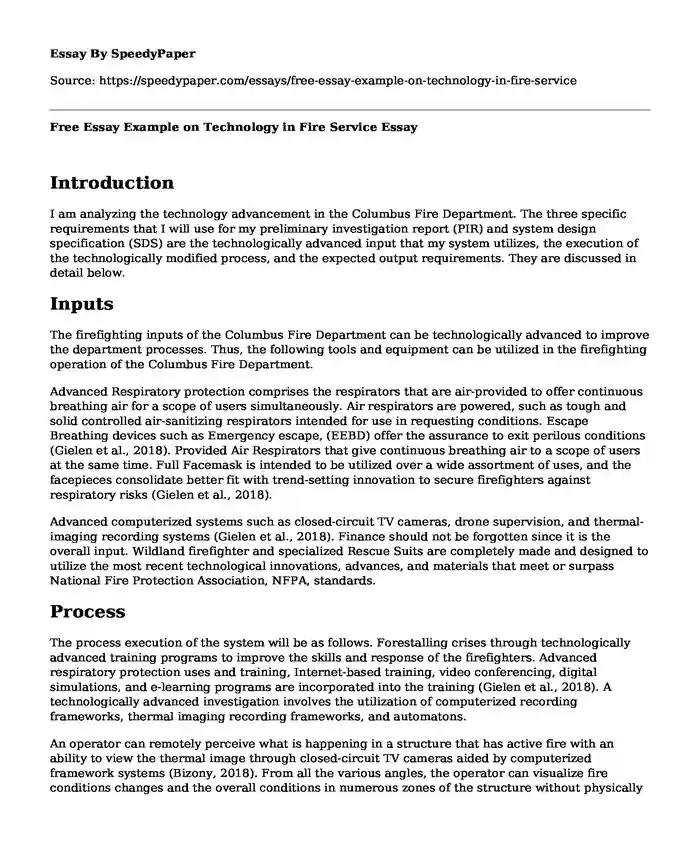
| Type of paper: | Essay |
| Categories: | United States Technology Public administration |
| Pages: | 3 |
| Wordcount: | 629 words |
Introduction
I am analyzing the technology advancement in the Columbus Fire Department. The three specific requirements that I will use for my preliminary investigation report (PIR) and system design specification (SDS) are the technologically advanced input that my system utilizes, the execution of the technologically modified process, and the expected output requirements. They are discussed in detail below.
Inputs
The firefighting inputs of the Columbus Fire Department can be technologically advanced to improve the department processes. Thus, the following tools and equipment can be utilized in the firefighting operation of the Columbus Fire Department.
Advanced Respiratory protection comprises the respirators that are air-provided to offer continuous breathing air for a scope of users simultaneously. Air respirators are powered, such as tough and solid controlled air-sanitizing respirators intended for use in requesting conditions. Escape Breathing devices such as Emergency escape, (EEBD) offer the assurance to exit perilous conditions (Gielen et al., 2018). Provided Air Respirators that give continuous breathing air to a scope of users at the same time. Full Facemask is intended to be utilized over a wide assortment of uses, and the facepieces consolidate better fit with trend-setting innovation to secure firefighters against respiratory risks (Gielen et al., 2018).
Advanced computerized systems such as closed-circuit TV cameras, drone supervision, and thermal-imaging recording systems (Gielen et al., 2018). Finance should not be forgotten since it is the overall input. Wildland firefighter and specialized Rescue Suits are completely made and designed to utilize the most recent technological innovations, advances, and materials that meet or surpass National Fire Protection Association, NFPA, standards.
Process
The process execution of the system will be as follows. Forestalling crises through technologically advanced training programs to improve the skills and response of the firefighters. Advanced respiratory protection uses and training, Internet-based training, video conferencing, digital simulations, and e-learning programs are incorporated into the training (Gielen et al., 2018). A technologically advanced investigation involves the utilization of computerized recording frameworks, thermal imaging recording frameworks, and automatons.
An operator can remotely perceive what is happening in a structure that has active fire with an ability to view the thermal image through closed-circuit TV cameras aided by computerized framework systems (Bizony, 2018). From all the various angles, the operator can visualize fire conditions changes and the overall conditions in numerous zones of the structure without physically being in the structure (Bizony, 2018).
Output
With the earlier mentioned advanced technological inputs being utilized to the technological, technical, and business process, the following output is likely to be achieved for the Columbus fire emergency department.
Generally, there will be limited injuries, demise, and property demolition because of the controlled fire, cataclysmic disaster, and different emergencies while giving convenient and successful crisis medical services (Bizony, 2018).
The remote monitoring results in an elaborate diagnosis analysis before and after tackling the emergency fire. This has an overall improvement to the firefighting efficiency of promptness and precision while limiting the risk of firefighter agents. The diagnosis significantly cuts the cost of the Columbus Fire Department, tackling fire emergencies since the actual cause and intensity of the fires are detected earlier. There is a great improvement in fire emergency safety of the surrounding population due to the prompt and strategic tackling of fire emergencies by the Columbus Fire Department. The profits and goodwill towards the Columbus Fire Department will thus significantly improve.
Conclusion
Incorporating technological advancements to the Columbus Fire Department processes will significantly improve the organization's efficiency in tackling fire emergencies and the safety of the subject residents.
References
Bizony, P. (2018). Where next, Columbus?[Space Technology]. Engineering & Technology, 13(1), 38-41.
Gielen, A. C., Frattaroli, S., Pollack, K. M., Peek-Asa, C., & Yang, J. G. (2018). How the science of injury prevention contributes to advancing home fire safety in the USA: successes and opportunities. Injury prevention, 24(Suppl 1), i7-i13.
Cite this page
Free Essay Example on Technology in Fire Service. (2023, Nov 10). Retrieved from https://speedypaper.com/essays/free-essay-example-on-technology-in-fire-service
Request Removal
If you are the original author of this essay and no longer wish to have it published on the SpeedyPaper website, please click below to request its removal:
- Business Essay Sample: The Problem of Forming Legal Entities
- Essay Sample: The Struggle for Democratic Stability in North Carolina and South Carolina
- Free Essay on the Effect that Social Network Has on Underage Users
- Law Essay Example: 4th Amendment Search and Seizure
- The Freedom of Speech - Censorship Essay Sample
- Armify: Revolutionizing Military Bullet Point Creation for Enhanced Evaluation and Career Progression
- Essay Example on Management of Diabetes
Popular categories




